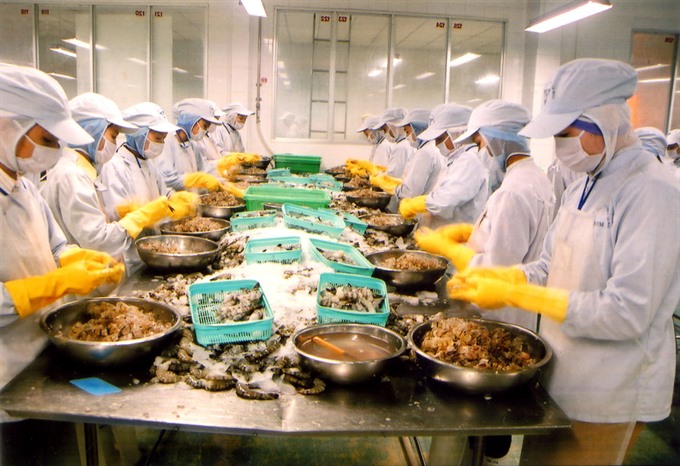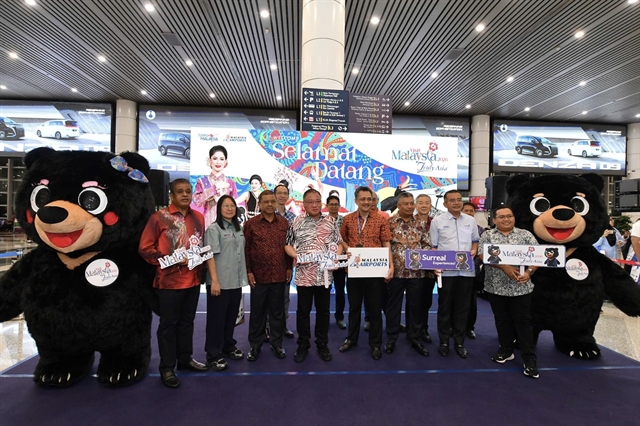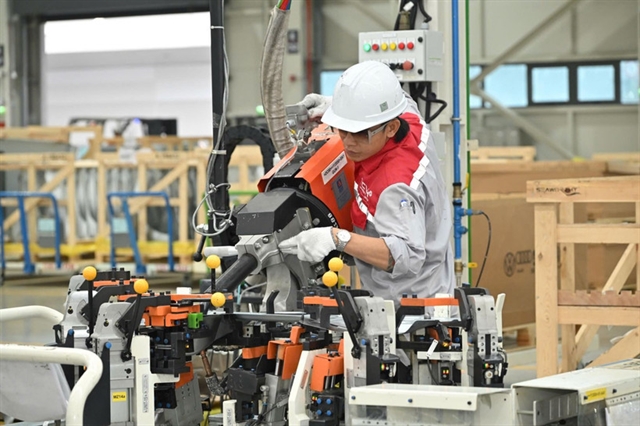 Society
Society

Combination models of shrimp breeding and other aquatic products, no use chemical, are bringing sustainable results and potential profit to farmers in the central coastal province of Phú Yên.
 |
| Workers process shrimps for export in the central province of Phú Yên. Breeding shrimp together with other aquatic products is providing sustainable results for farmers in the province. — VNA/VNS Photo Hà Thái |
PHÚ YÊN — Breeding shrimp together with other aquatic products is preventing disease without using chemicals and providing sustainable results for farmers in the central coastal province of Phú Yên.
In the past, breeding black-tiger shrimp and white shrimp at high density resulted in epidemics that forced breeders to use chemicals to treat polluted water. Now the province has implemented effective combined breeding models, which helps to minimise pollution.
According to tests conducted by the Đông Hòa District’s veterinary laboratory, shrimp bred there were mainly infected with acute liver-and-marrow necrosis, and white-spot and red-body disease.
To limit the epidemic and environmental pollution, shrimp breeders have been breeding shrimp with other aquatic products, such as blue crab, tilapia.
"I am breeding tilapia with shrimp in a family pond. I see the water environment in the pond is better than previous years when I bred only shrimp,” said shrimp breeder Nguyễn Bút of Hòa Tâm Commune.
“The pond’s bottom is no longer polluted by food leftovers, while the shrimps grow rapidly. Although the profit is lower than the model of only shrimp breeding, I earn VNĐ100million (US$4,400) to VNĐ120 million from 5 sào ( 1 sào equals 360sq.m) of water surface per crop. Every year I can raise two crops and the water environment is still guaranteed."
Another shrimp breeder, Huỳnh Hùng of Hòa Hiệp Nam Commune, who is breeding shrimp and blue crabs, said "Firstly, I feed baby shrimp with microbiology fermented bran, and the shrimp’s growth is very good. After 15 days, I give them industrial feed," Hùng said.
Đỗ Kim Đồng, chief of Đông Hòa District’s agriculture department, said that in 2016, local authorities supported 600kg of baby tilapias for shrimp farmers in four communes and towns to develop the combined model of shrimp breeding.
“Tilapias can consume feed leftovers, limiting water pollution," Đồng said.
Meanwhile, in neighbouring district of Tuy An, shrimp farmers are breeding shrimp together with oysters, blue crabs, seaweed and fish.
Trần Sáu, head of Tuy An District’s agriculture department said "The combined shrimp raising model is bringing profit to breeder. The model is suitable for environmental condition of Ô Loan Lagoon.”
Expanding model
Over the past few years, Phú Yên Province’s Agricultural Promotion Centre has built up several aquatic-product breeding models that utilises new and advanced technology.
Nguyễn Khắc Tân, the centre’s deputy director, said from 2010 to 2012, farmers in two communes Xuân Lộc and Hà Xuân Đông were the first in the province to breed shrimp together with tilapias and seaweed. The combination created clean water and limited the penetration and development of disease bacteria.
The centre has also developed combination models of black-tiger shrimp (also called prawn in Europe) and blue crabs in Sông Cầu Town, and black-tiger shrimp with sea cucumber in Xuân Hải Commune.
Another model developed by the centre was VietGAP-standard shrimp breeding in Hòa Hiệp Nam Commune of Đông Hòa District.
"Each model has its advantages and disadvantages. Therefore, although most models have been implemented and proved sustainable effectiveness, technicians and experts must evaluate what model will be suitable for each farming area," Tân said.
Phú Yên Province’s Department of Agriculture and Rural Development director Nguyễn Trọng Tùng says the province’s overall goal is to develop its shrimp breeding industry into a large-scale model, adaptable to climate change and ecologically friendly. In the 2017-20 period, total shrimp farming area in the province is estimated to reach about 1,940ha.
The department also requested local agricultural departments to complete detailed planning for shrimp breeding and infrastructure investment soon in order to bring into full play the potential for sustainable shrimp farming. — VNS




